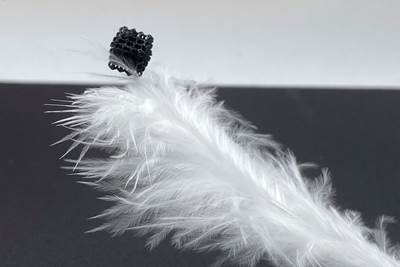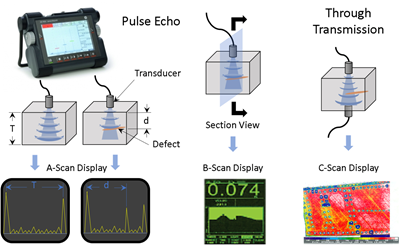Breakthrough material provides tunable radar absorption, infrared thermal camouflage
Researchers at Jiangsu University of Science and Technology demonstrated obscured IR signatures of objects from human hands to aircraft fuselages, exceeding current stealth technologies at only 2.77 millimeters thickness.
Researchers have long sought to develop multifunctional stealth materials capable of evading detection across different parts of the electromagnetic spectrum. However, achieving compatible stealth performance across varying radar, infrared and other bands has persisted as a major challenge. Materials and coatings optimized for radar absorbance often perform poorly for infrared concealment, while infrared-stealth layers may lack radar-wave attenuation. This incompatibility stems from the distinct absorption mechanisms involved across different wavelengths.
Originally reported on by Nanowerk’s Michael Berger, recent work led by researchers at Jiangsu University of Science and Technology (JUST, China) demonstrates a breakthrough tunable stealth material design able to provide adjustable radar absorption and infrared thermal camouflage from a single lightweight aerogel structure. Inspired by the multilayered architecture of plant leaves, the researchers developed a bionic scaffold by synergistically combining 1D cellulose fibers, 2D MXene sheets and liquid metal microspheres. The work, “Liquid Metal-MXene-Based Hierarchical Aerogel with Radar-Infrared Compatible Camouflage,” has been published in Advanced Functional Materials.
The resulting biomimetic configuration resembles the epidermis, vascular bundles and thylakoid structures found in foliage (read more about biomimicry). It exhibits a hierarchical porous morphology with interconnected voids spanning from its surface through the interior bulk. This complex structural arrangement facilitates optimized impedance matching and establishes extended electromagnetic wave propagation paths to enable strong wideband absorption.
Moreover, simply by tuning the proportion of constituents, the permittivity, absorption intensity, bandwidth and wavelength selectivity can be readily modified. The large interfacial area from the heterogeneous components promotes pronounced polarization phenomena to dissipate impinging radiation into heat.
Optimization yielded maximum radar reflection losses up to 73 decibals across a 7-gigahertz range at just 2.77-millimeter thickness — reportedly significantly outperforming existing market stealth solutions. Durability testing further revealed the material maintains a 60% infrared camouflage efficiency even after 6 months of continuous 400°C exposure.
Tunable permittivity stealth materials may find versatile roles ranging from shielding sensitive electronics to visually cloaking buildings or vehicles
JUST researchers posit the long-term thermal concealment arises from enhanced oxidation resistance imparted by a protective dopamine coating on the MXene flakes. This coating strengthens interfacial binding and reduces structural degradation at high temperatures. Multiscale channels throughout the bionic aerogel morphology also assist convective heat dissipation.
Varying the architecture of samples also enabled both macro- and micro-scale camouflage applications. Small material segments effectively obscured infrared signatures of objects ranging from human extremities to entire aircraft fuselages. Meanwhile, samples machined into particular shapes provided camouflage against visual detection. For instance, an etched aerogel sheet resembled foliage when placed atop a simulated tank.
The material’s electromagnetic wave absorbance even proved highly effective under simulated operating conditions on a model aircraft airframe across sweep angles from zero to 180º. According to simulations, radar cross sections decreased by more than 50 square meter decibals compared to an uncoated equivalent frame. This adjustable stealth performance holds promise for enabling a new generation of radar-evading and infrared-concealing defense technologies.
Ultimately, the bio-inspired heterogeneous design paradigm sidesteps longstanding limitations of existing approaches reliant on multilayer composites or electronically tuned metamaterials. Importantly, the facile processing empowers rapid iterative prototyping to identify optimized configurations.
By harnessing the synergies between the constituents’ characteristics, a single multipurpose aerogel structure attained functionality rivaling far more intricate structures. This greatly enhances technological readiness for transitioning such biomimetic materials from the lab towards defense applications. Although the radar and infrared stealth capabilities currently serve a military focus, the novel materials configuration could eventually expand towards benefiting civilian domains as well.
With further development, tunable permittivity stealth materials may find versatile roles ranging from shielding sensitive electronics to visually cloaking buildings or vehicles. Optimization for commercial wireless infrastructure could even yield energy efficiency improvements. Some experts speculate that the eventual transition towards higher frequency networks for 6G and beyond could likewise incentivize such radar-wave engineered materials to mitigate interference issues.
In the nearer term, the most disruptive battlefield impacts may arise from smaller-scale infrared camouflage enabling covert operations. Where previous generations of specialized suits proved bulky and inconvenient, a malleable concealment layer could cloak wore by special forces to evade night vision or thermal detection. Mounted panels similarly promise to hide critical infrastructure from aerial thermal surveillance.
However, the technology’s offensive applications warrant caution as well. Adversaries equipped with such tunable stealth materials could pose unprecedented risks of infiltration and strategic deception. The researchers rightfully avoided speculating on the technology’s potential weapons development roles. Nonetheless, the public should remain cognizant that any significantly advanced stealth capability includes inherent dual-use potential for empowering either defense or aggression.
With so much future promise along with risks, the researchers’ breakthrough represents a technological inflection point. By overcoming longstanding barriers to multifunctional stealth materials, this bio-inspired advance furnishes a foundation for other groups to build upon with further progress toward practical defense applications.
Read the full article and see original images here.
Read Next
3D-printed, self-assembled graphene demonstrates potential for hierarchical composites
A 3D-printed template-directed assembly method assembles graphene into a multi-scale programmed structure with tunable mechanical properties, low density and high Young’s modulus.
Read MoreNondestructive inspection methods available to composites manufacturers
An overview of composite laminate inspection techniques ranging from manual testing methods to more advanced, noncontact options.
Read MoreKarman Space & Defense expands carbon-carbon composites production
Increased capacity supports growing demand for MG resin and ultrahigh-temperature materials used in space and defense applications.
Read More



















.jpg;maxWidth=300;quality=90)



